My succulents, vines, and groundcovers: Alive, dead or in-between? Evaluating plants 2 months after Texas freeze
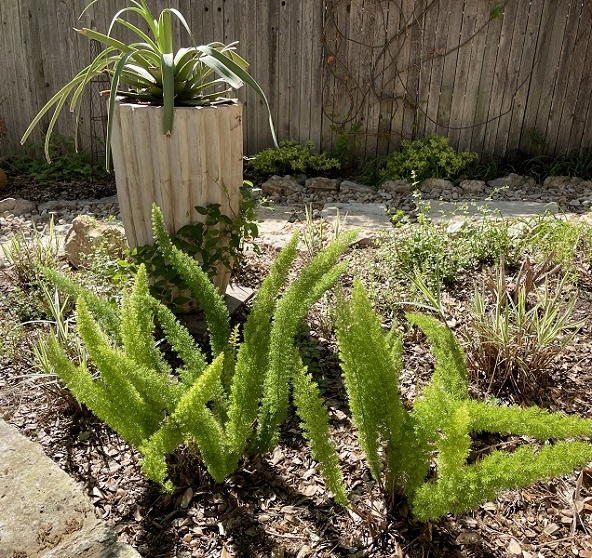
Today I’m taking a look at all the remaining plants in my garden: my small succulents and cacti, vines, and groundcovers, as well as bulbs and rhizomes and a few annuals. I grow some of my small succulents in pots, and I’m omitting from this list any that I was able to bring indoors that freezing week.
But first, the backstory.
Texas gardeners are feverishly comparing notes about plant survivors and croakers after February’s Big Freeze. I’m doing the same and documenting how every plant in my garden fared. Please see my first post in this series for the introduction and for notes about my trees.
Asterisks indicate plants native to Texas. Plants that were stunted, maimed, or killed by the freeze are in bold, for easier searching.
Succulents & Cacti
- Aloe ‘Blue Elf’: Killed in a pot. My plant had survived about 15 winters in its pot until this year.
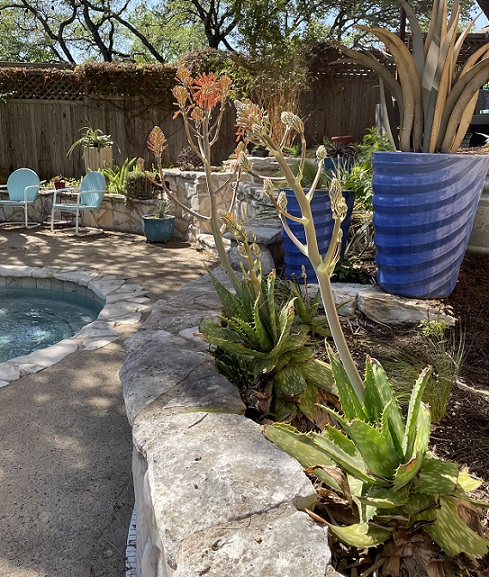
- Aloe maculata (formerly Aloe saponaria) – Soap aloe: 1 killed, 2 maimed, and others killed to the roots. Despite this tally, I’m actually really impressed by the survivors. I’ve been growing a trio for about 10 years in a bed with a sunny wall for protection. One of those melted and had to be removed. The other two survived, albeit with squishy arms that had to be cut off. I replaced the one that died with a pup from a pot I’d brought inside, and all three are now blooming. Another cluster in a less protected spot in the garden died to the roots but are coming back.
- Bulbine frutescens – Orange bulbine: Killed in a container. Yellow bulbine: Killed in a raised bed.
- Delosperma cooperi – Ice plant: Killed in a container.
- Echinocereus pectinatus var. coahuila – Coahuila lace cactus: Killed in a container.
- Euphorbia rigida – Gopher plant: Survived like a champ and bloomed soon after the thaw.
- Euphorbia rigida ‘Winter Blush’ – Gopher plant ‘Winter Blush’: Survived like a champ and bloomed soon after the thaw.
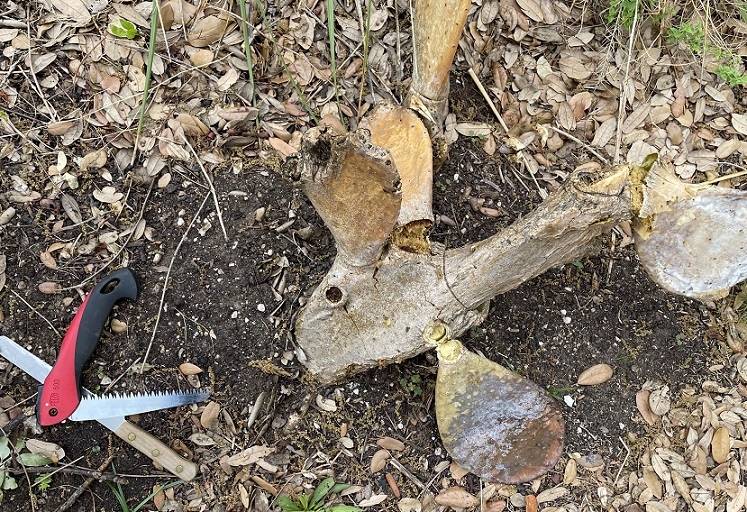
- Opuntia cacanapa ‘Ellisiana’ – Spineless prickly pear*: Killed to the ground and only just now starting to come back from the roots. I’m surprised this native opuntia was so devastated, but at least it’s alive.
- Opuntia ficus-indica – Indian fig: Killed to the ground and only just now starting to come back from the roots.
- Opuntia gomei ‘Old Mexico’*: Killed to the ground. I cut it back to the trunk-like bottom layer, and it soon started coming back from the roots. It has had the quickest return rate of all my opuntias.
- Sedum palmeri – Palmer’s sedum: Completely unfazed in the ground.
- Sedum reflexum ‘Blue Spruce’ – ‘Blue Spruce’ sedum: Completely unfazed in a pot.
- Sedum spurium ‘Dragon’s Blood’: Completely unfazed in a pot.
Vines
- Bignonia capreolata ‘Tangerine Beauty’ – ‘Tangerine Beauty’ Crossvine*: Some top growth turned brown, but it swiftly recovered and flowered soon after the freeze.
- Clematis pitcheri – Purple leatherflower*: Completely unfazed. It was dormant during the freeze but leafed out normally afterward.
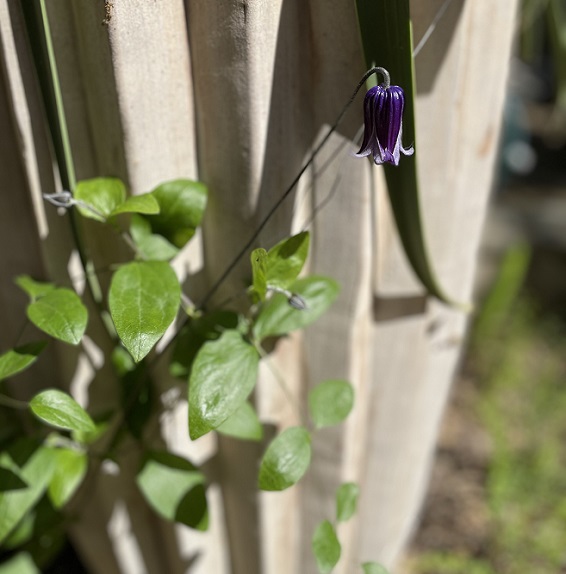
- Clematis ‘Rooguchi’: Completely unfazed. It was dormant during the freeze but leafed out normally afterward.
- Clematis viticella ‘Etoile Violette’: Completely unfazed. It was dormant during the freeze but leafed out normally afterward.
- Lonicera sempervirens – Coral honeysuckle*: Completely unfazed. It was dormant during the freeze but leafed out normally afterward.
- Mascagnia macroptera – Butterfly vine, or gallinita: Killed back completely, but there are a couple of tiny tendrils coming up from the roots. I cut down the woody vine and am watching to see if it will recover.
- Solanum jasminoides – White potato vine: Killed back completely, but there are a few tendrils coming up from the roots.
- Trachelospermum jasminoides – Star jasmine: Killed back completely, but there are a few tendrils coming up from the roots.
Groundcovers
- Asparagus densiflorus ‘Myersii’ – Foxtail fern: Killed to the ground, but the snow cover saved them. Nearly all of my many plants recovered swiftly to full size except a couple of newly planted ones and those in containers that were left outside.
- Dianthus gratianopolitanus ‘Bath’s Pink’ – Cheddar pink ‘Bath’s Pink’: Completely unfazed.
- Oxalis triangularis – Purple oxalis: A big one in a pot was killed, but others in the ground came back from the roots.
- Polygonum capitatum ‘Magic Carpet’ – Pink knotweed: Killed to the roots with little signs of life except for a few small sprigs. Still, I’m fairly sure this tenacious plant will recover.
- Ruellia brittoniana ‘Katie’ – Dwarf Mexican petunia: Died to the roots as usual but coming back strong.
- Ruellia brittoniana ‘Southern Star Blue’ – Dwarf Mexican petunia: Died to the roots but coming back strong.
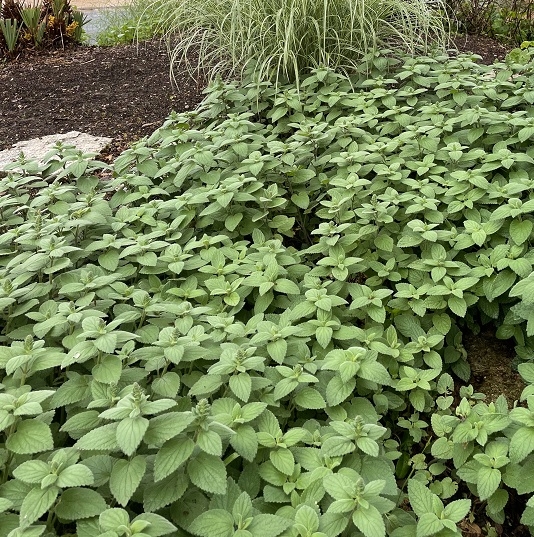
- Scutellaria ovata – Heartleaf skullcap*: Some freeze-burned top growth, but it quickly rallied and is lush and full and about to bloom.
- Scutellaria suffrutescens ‘White’: Died to the roots but coming back strong.
- Scutellaria x ‘Dark Violet’- Purple skullcap ‘Dark Violet’*: Died to the roots but coming back strong.
- Scutellaria wrightii – Purple skullcap*: Died to the roots but coming back strong.
- Stachys byzantina – Lamb’s ear: No damage except to a newly planted one. The others are completely fine.
- Stemodia lanata – Woolly stemodia*: Some die-back as usual, but this is a warm-season grower, so I’ll have a better idea by the end of May.
- Tradescantia pallida – Purple heart: Died to the roots as usual but has already made a full recovery.
- Verbascum spp. – Mullein: Completely unfazed and a couple are about to bloom.
Bulbs & Rhizomes
- Allium tuberosum – Garlic chives*: Completely unfazed. It was dormant during the freeze but leafed out normally afterward.
- Iris germanica – Bearded iris: Completely unfazed.
- Iris spuria – Spuria iris, gold: Completely unfazed.
- Lycoris aurea – Yellow spider lily: Too early to tell for these fall-blooming bulbs.
- Lycoris radiata – Spider lily: Too early to tell for these fall-blooming bulbs.
- Rhodophiala bifida – Oxblood lily: Too early to tell for these fall-blooming bulbs.
- Zephryanthes ‘Labuffarosea’ – Pink rain lily: Look fine but haven’t bloomed yet.
Annuals
- Capsicum annuum ‘Black Pearl’ – ‘Black Pearl’ ornamental pepper (behaves as a perennial some years): I may have to reclassify this as a perennial. This “annual” has come back from the roots for several years and is coming back again this year. Amazing!
- Cuphea llavea – Bat-face cuphea (behaves as a perennial some years): Same with this one. It’s coming back from the roots.
- Lupinus texensis – Texas bluebonnet*: Completely unfazed (except by the deer, which eventually ate them all).
This wraps up my inventory of all my plants two months after the epic February freeze. Click for my earlier posts about:
- Trees
- Shrubs, Sub-Shrubs, & Woody Perennials
- Perennials
- Woody Lilies and Bromeliads
- Grasses, Sedges, and Bamboos
- Small Succulents, Cacti, Vines, Groundcovers & More
__________________________
Digging Deeper
Come learn about gardening and design at Garden Spark! I organize in-person talks by inspiring designers, landscape architects, authors, and gardeners a few times a year in Austin. These are limited-attendance events that sell out quickly, so join the Garden Spark email list to be notified in advance; simply click this link and ask to be added. Season 8 kicks off in fall 2024. Stay tuned for more info!
All material © 2025 by Pam Penick for Digging. Unauthorized reproduction prohibited.


Love this–thank you so much! In east Austin, my plants fared the same as yours, with these exceptions: my purple skullcap, dark violet skullcap, white spider lilies, crinum lilies, & oxblood lilies were surprisingly unfazed & kept their green leaves–I’m guessing thanks to the snow. My Katrina irisis died to the roots but have recovered well. Re: annuals, I’m surprised at how many of my gomphrena plants are coming back from the roots.
As I need to find some new plants to put in where I had huge pittosporums & sandankwa viburnums that died in the freeze, your lists & other wonderful blog posts are helping me & so many others create new wishlists & think creatively about where to go from here. Thank you, Pam!
Now that you mention it, Kate, I think there were some leaves on my skullcaps too. But I ended up cutting them all to the ground (or nearly) to rejuvenate them. And you’re right — the oxblood lilies did keep their green leaves after the snow melted. I’m assuming those bulbs will be fine since they were tucked deep in the earth. But I won’t know for sure until September. 🙂
Good luck with your redesign where you lost those big evergreens. It’s hard to lose big plants! But I’m sure you’ll find a new way forward or simply decide to replant. I’m doing a mix of both.
Thanks Pam, for a great summary of how all your plants fared. I’ve experienced much the same, except for my opuntias. I have 5 clumps of spineless prickly pear, planted in a raised berm out in the open, and 4 of them only dropped a few pads. The plant in the shadiest location suffered the most, and lost about half of its top growth, but still fared ok. So I surmise amount of sun is what made a difference, but who really knows. On the other hand, my 3 clumps of Old Mexico suffered far greater damage. One in a pot died outright (no surprise), and 2 planted last September in the ground died back completely. One seems to be *slowly* coming back, thankfully. I guess it’s all about microclimates and how established things are. Thanks again for your very helpful posts.
Thank you sharing about your opuntias, Maggie. It’s so interesting to hear about the ones that didn’t suffer much damage. It could be the sunnier location, for sure, and it could also be your raised berm that saved them. Good drainage often makes all the difference for succulents during cold weather. Most of mine are in some shade because my whole garden is under live oaks. But my ‘Old Mexico’ is on a slight slope, and maybe the better drainage there helped it while the ‘Ellisiana’ is on flat ground. Both died to the roots, but ‘Old Mexico’ is coming back much faster.
Now if I could just figure out why my two Texas mountain laurels reacted so differently! 😉
Lots to be happy about on this list. I was started to see the Delosperma kicked the bucket as it’s one of those things I’ve always thought was indestructible but then I’ve never dealt with cold anything like that you experienced.
I thought it was pretty cold tolerant too, Kris, and it may have just been that mine wasn’t particularly healthy. Succulents sometimes struggle with our unrelenting summer heat and humidity and just have to be replaced more quickly.
The only plants I lost were an olive tree, bay tree (which was already declining due to borers), spineless prickly pear, bulbine, and a rosemary. Everything else is either fine or coming back from the roots. The bearded iris seem to have liked the cold; they are putting on showier blooms than normal
I agree, Karen. The irises seem pleased with a week of real winter! That’s great news too on losing just a few plants. Sounds like you’re wisely planting native or very hardy plants. 🙂
Glad to see you have quite a few survivors. Hooray!
Me too!
Thank you for each of the posts in this series, Pam! I’m fairly new to Hill Country and was blessed to purchase a home that was beautifully landscaped with all Texas natives! There were a few bare spots and I’ve loved reading which plants were super stars after the freeze! Looks like I’ve got so much to chose from to fill in those spots. I’m not too good with identification but my biggest problem was with my 4 large Spineless Cactus. All suffered terribly and all but one had to be cut back to the base. I’ve plenty new growth on the one that kept a few pads and only one of the others has a tiny little pad emerging from its base. I have 60+ live oaks that I’m patiently & anxiously waiting to see if they recover. At least I’ve got green in the garden again! Love reading your posts and your pictures are wonderful!
That’s a lot of oaks to care for! I hope they all make a full recovery, and congrats on having a garden of survivors. I bet those prickly pears will start to come back this summer.